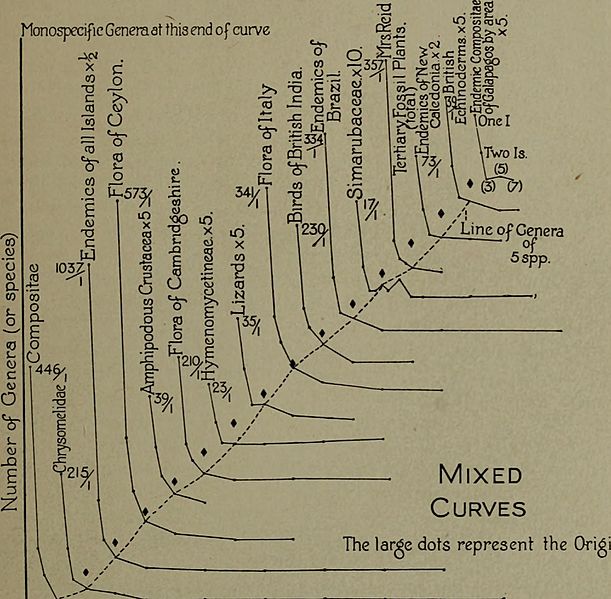Image: Age and area; a study in geographical distribution and origin of species (1922) (14592184457)

Description: Identifier: ageareastudyinge00will_0 (find matches) Title: Age and area; a study in geographical distribution and origin of species Year: 1922 (1920s) Authors: Willis, J. C. (John Christopher), 1868-1958 Subjects: Biogeography Evolution Publisher: Cambridge (Eng.) The University press Contributing Library: Wellesley College Library Digitizing Sponsor: Boston Library Consortium Member Libraries View Book Page: Book Viewer About This Book: Catalog Entry View All Images: All Images From Book Click here to view book online to see this illustration in context in a browseable online version of this book. Text Appearing Before Image: shouldbe arranged in the same way. The genera arriving for examplein Britain will not all arrive simultaneously, but some will arrivesooner than others, and these will tend to be the larger genera ofthe nearest source of supply, for the larger genera will usually bethe more widespread. The ultimate result will tend to be thatthese genera will not only arrive first, but will tend to be repre-sented by more species, so that one will expect the most widelydistributed species in the large genera (i.e. large for the countryin question, being represented there by many species) to bemore widely dispersed than those of the small. This we havealready seen to be the case in the most striking way (p. 114). But one may push this arithmetical regularity further yet. If ch. xxii) GEOGRAPHICAL DISTRIBUTION 237 one take the number of species per family in the British flora,one finds it to increase steadily with the number of genera; thereare no breaks, as one would be inclined to expect. The families Text Appearing After Image: ns Number of species (or size of area .J Mixed curves, to show the close agreement of the hollow curves, whetherderived from families of plants grouped by sizes of genera (Compositae,Hymenomycetineae, Simarubaceae), families of animals (Chrysomelidae,Amphipodous Crustacea, Lizards), endemic genera grouped by sizes(Islands, Brazil, New Caledonia), local floras grouped by (local) sizes ofgenera (Ceylon, Cambridgeshire, Italy), local faunas (Birds of BritishIndia, British Echinoderms), Tertiary fossils by sizes of genera, orEndemic Compositae of the Galapagos by area. (By courtesy of theEditor of Nature.) with one genus show an average of 2-2 species per family, thosewith two an average of 8-3, with three of 10-7, with four of 12-3,with five, six or seven genera of 15, with eight, nine, or ten of 238 GEOGRAPHICAL DISTRIBUTION (pt. ii 40, and with more genera than ten of 73. The numbers increaseregularly with the number of genera. One may even find, here as elsewhere, that (as a general r Note About Images Please note that these images are extracted from scanned page images that may have been digitally enhanced for readability - coloration and appearance of these illustrations may not perfectly resemble the original work.
Title: Age and area; a study in geographical distribution and origin of species (1922) (14592184457)
Credit: https://www.flickr.com/photos/internetarchivebookimages/14592184457/ Source book page: https://archive.org/stream/ageareastudyinge00will_0/ageareastudyinge00will_0#page/n252/mode/1up
Author: Internet Archive Book Images
Permission: At the time of upload, the image license was automatically confirmed using the Flickr API. For more information see Flickr API detail.
Usage Terms: No known copyright restrictions
License: No restrictions
License Link: https://www.flickr.com/commons/usage/
Attribution Required?: No
Image usage
The following 2 pages link to this image:

